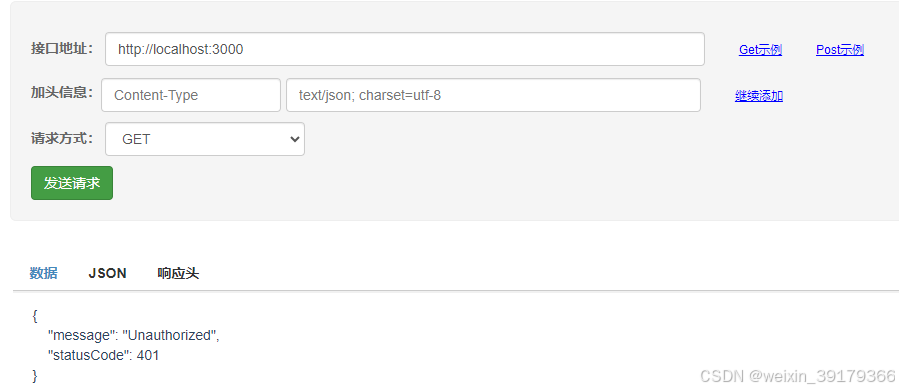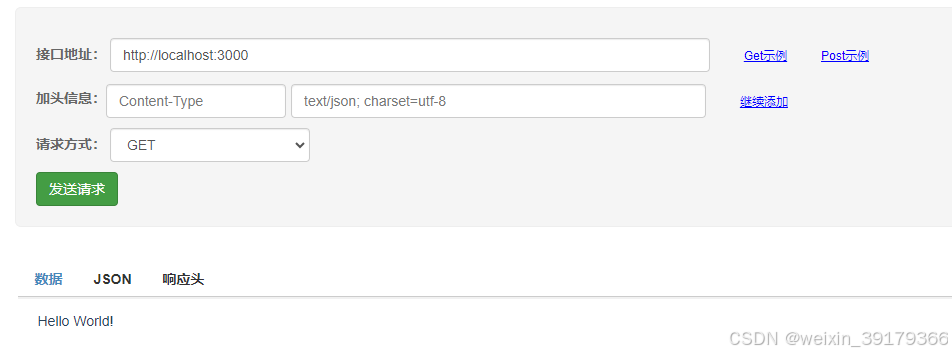一、NestJS使用crypto加密
使用NodeJS内置的加密模块crypto,使用 AES(高级加密系统)'aes-256-ctr' 算法 CTR 加密方式。
1、在.env.development配置文件中配置
#CRYPTO
CRYPTO_KEY=d05c11de4bec30f8cc195d21e9d9dcb7
CRYPTO_IV=12345678901234562、在项目中添加一个utils模块,并手动添加一个crypto.service.ts
nest g module utilscrypto.service.ts文件内容,并从utils模块中导出CryptoService
import { Injectable } from '@nestjs/common';
import { ConfigService } from '@nestjs/config';
import { createCipheriv, createDecipheriv, scrypt } from 'crypto';
import { promisify } from 'util';
@Injectable()
export class CryptoService {
private readonly iv: Buffer
private readonly key: Buffer
constructor(private readonly configService: ConfigService) {
this.iv = Buffer.alloc(16, this.configService.get<string>("CRYPTO_IV"), 'hex')
this.key = Buffer.alloc(32, this.configService.get<string>("CRYPTO_KEY"), 'hex')
}
async encryption(source: string): Promise<string> {
const key = (await promisify(scrypt)(this.key, 'salt', 32)) as Buffer;
const cipher = createCipheriv('aes-256-ctr', key, this.iv)
let encrypted = cipher.update(source, 'utf8', 'hex')
encrypted += cipher.final('hex')
return encrypted
}
async decryption(encrypted: string): Promise<string> {
const key = (await promisify(scrypt)(this.key, 'salt', 32)) as Buffer;
const decipher = createDecipheriv('aes-256-ctr', key, this.iv)
let decrypted = decipher.update(encrypted, 'hex', 'utf8')
decrypted += decipher.final('utf8')
return decrypted
}
}
3、在app.controller.ts中使用加密,解密。添加以下方法:
先注入CryptoService
constructor(
private readonly appService: AppService,
private readonly configService: ConfigService,
private readonly cryptoService: CryptoService
) {}再加入加密解密方法
@Public()
@Get('encryption/:encryption')
encryption(@Param('encryption') encryption: string) {
return this.cryptoService.encryption(encryption)
}
@Public()
@Get('decryption/:decryption')
decryption(@Param('decryption') decryption: string) {
return this.cryptoService.decryption(decryption)
}这里顺带修改一下前面我们创建的user表,新增时,把密码加密,修改user.service.ts文件中,create(createUserDto: CreateUserDto)方法,把密码加密:
首先修改user.module.ts,在providers中加入CryptoService,
在user.service.ts中注入CryptoService
constructor(
@InjectRepository(User)
private readonly userRepository: Repository<User>,
private readonly cryptoService: CryptoService) {}添加加密密码的动作
async create(createUserDto: CreateUserDto) {
try {
createUserDto.password = await this.cryptoService.encryption(createUserDto.password)
return this.userRepository.save({ ...createUserDto })
} catch (error) {
throw new HttpException({
status: HttpStatus.INTERNAL_SERVER_ERROR,
error: 'This is a service error message',
}, HttpStatus.INTERNAL_SERVER_ERROR, {
cause: error
});
}
}二、NestJS使用JWT认证
文档地址:
pnpm install --save @nestjs/jwt2、添加AuthModule,AuthService,AuthController
nest g module auth
nest g service auth
nest g controller auth在auth.module.ts中,导入JwtModule
import { Module } from '@nestjs/common';
import { AuthService } from './auth.service';
import { AuthController } from './auth.controller';
import { UserModule } from 'src/user/user.module';
import { JwtModule } from '@nestjs/jwt';
import { ConfigService } from '@nestjs/config';
import { CryptoService } from 'src/utils/crypto.service';
@Module({
imports: [UserModule,
JwtModule.registerAsync({
global: true,
inject: [ConfigService],
useFactory: (configService: ConfigService) => ({
secret: configService.get<string>('JWT_SECRET'),
signOptions: { expiresIn: '3600s' },
}),
}),
],
providers: [AuthService, CryptoService],
controllers: [AuthController],
exports: [AuthService]
})
export class AuthModule {}
在auth.service.ts中添加登录生成token的方法,这里做了一下数据正确性验证。
import { BadRequestException, HttpException, Injectable, UnauthorizedException } from '@nestjs/common';
import { JwtService } from '@nestjs/jwt';
import { I18nService } from 'nestjs-i18n';
import { I18nTranslations } from 'src/generated/i18n.generated';
import { UserService } from 'src/user/user.service';
import { CryptoService } from 'src/utils/crypto.service';
@Injectable()
export class AuthService {
constructor(
private readonly userService: UserService,
private readonly jwtService: JwtService,
private readonly cryptoService: CryptoService,
private readonly i18n: I18nService<I18nTranslations>
) {}
async signIn(
account: string,
password: string,
captcha: string
): Promise<{ access_token: string }> {
//先固定,后面再处理
if (captcha != "1234")
throw new BadRequestException(this.i18n.t('user.LoginValid.CAPTCHA_ERROR'));
const user = await this.userService.findOneByAccount(account);
if (user == null || user == undefined)
throw new BadRequestException(this.i18n.t('user.LoginValid.ACCOUNT_ERROR'));
if (await this.cryptoService.decryption(user.password) !== password)
throw new BadRequestException(this.i18n.t('user.LoginValid.PASSWORD_ERROR'));
const payload = { sub: user.id, account: user.account };
return {
access_token: await this.jwtService.signAsync(payload),
};
}
}在auth.controller.ts中添加对外暴露的接口:
import {
Body,
Controller,
Get,
HttpCode,
HttpStatus,
Post,
Request,
UseGuards
} from '@nestjs/common';
import { AuthGuard } from './auth.guard';
import { AuthService } from './auth.service';
import { Public } from './public.decorator';
import { LoginInDto } from './dto/auth.login.dto';
import { ApiOperation } from '@nestjs/swagger';
@Controller('auth')
export class AuthController {
constructor(private authService: AuthService) {}
@Public()
@HttpCode(HttpStatus.OK)
@Post('login')
@ApiOperation({ summary: '登录' })
signIn(@Body() signInDto: LoginInDto) {
return this.authService.signIn(signInDto.account, signInDto.password, signInDto.captcha);
}
@UseGuards(AuthGuard)
@Get('profile')
@ApiOperation({ summary: '获取当前登录人' })
getProfile(@Request() req) {
return req.user;
}
}这里我们创建了一个DTO,代码如下(也是进行了i18n国际化):
import { ApiProperty } from "@nestjs/swagger"
import { IsNotEmpty, Length } from "class-validator"
import { i18nValidationMessage } from 'nestjs-i18n'
import { I18nTranslations } from "src/generated/i18n.generated"
export class LoginInDto {
@IsNotEmpty({ message: i18nValidationMessage<I18nTranslations>('user.UserValid.NOT_EMPTY') })
@Length(6, 30, { message: i18nValidationMessage<I18nTranslations>('user.UserValid.LENGTH') })
@ApiProperty()
account: string
@IsNotEmpty({ message: i18nValidationMessage<I18nTranslations>('user.UserValid.NOT_EMPTY') })
@Length(8, 16, { message: i18nValidationMessage<I18nTranslations>('user.UserValid.LENGTH') })
@ApiProperty()
password: string
@IsNotEmpty({ message: i18nValidationMessage<I18nTranslations>('user.UserValid.NOT_EMPTY') })
@Length(4, 4, { message: i18nValidationMessage<I18nTranslations>('user.UserValid.LENGTH') })
@ApiProperty()
captcha: string
}
至此我们src/i18n/xxx/user.json,结构如下(其他语言包user.json也要添加LoginValid):
{
"UserValid": {
"NOT_EMPTY": "{property} cannot be empty",
"INVALID_EMAIL": "{property} email is invalid",
"INVALID_BOOLEAN": "{property} is not a boolean",
"MIN": "{property} with value: \"{value}\" needs to be at least {constraints.0}",
"MAX": "{property} with value: \"{value}\" needs to be less than {constraints.0}",
"LENGTH": "{property} length needs bigger than and equals to {constraints.0} and Less than or equal to {constraints.1}",
"DATE": "{property} with value: \"{value}\" must can convert to Date"
},
"LoginValid": {
"PASSWORD_ERROR": "password is wrong",
"ACCOUNT_ERROR": "account is wrong",
"CAPTCHA_ERROR": "verification code is wrong"
}
}3、因为真实项目肯定要全局验证是否登录,以保护自己的资源的安全性,所有我们需要全局应用token验证,这里我们添加一个AuthGuard,并设置成全局作用域。
添加auth.guard.ts文件,并创建AuthGuard守卫
import { CanActivate, ExecutionContext, Injectable, UnauthorizedException } from "@nestjs/common";
import { JwtService } from '@nestjs/jwt';
import { Request } from 'express';
import { Reflector } from "@nestjs/core";
import { IS_PUBLIC_KEY } from "./public.decorator";
import { ConfigService } from "@nestjs/config";
@Injectable()
export class AuthGuard implements CanActivate {
constructor(private jwtService: JwtService
, private reflector: Reflector
, private configService: ConfigService) {}
async canActivate(context: ExecutionContext): Promise<boolean> {
const isPublic = this.reflector.getAllAndOverride<boolean>(IS_PUBLIC_KEY, [
context.getHandler(),
context.getClass(),
]);
if (isPublic) {
return true;
}
const request = context.switchToHttp().getRequest()
const token = this.extractTokenFromHeader(request)
if (!token)
throw new UnauthorizedException()
try {
const payload = await this.jwtService.verifyAsync(token, {
secret: this.configService.get<string>('JWT_SECRET')
})
request['user'] = payload
} catch {
throw new UnauthorizedException()
}
return true
}
private extractTokenFromHeader(request: Request): string | undefined {
console.log(request)
console.log(request.headers)
const [type, token] = request.headers.authorization?.split(' ') ?? [];
return type === 'Bearer' ? token : undefined;
}
}这里可以看到我们从请求头部获取到Bearer Token,解析token,并把信息放到request.user中,这样我们就可以知道是谁访问了接口。
设置AuthGuard全局作用域(在app.module.ts文件中providers中添加代码)
{
provide: APP_GUARD,
useClass: AuthGuard,
},4、此时我们就全局应用了token认证了。如果调用接口不传token,会返回401状态码(默认)。

5、在AuthGuard守卫具体代码中我们可以看到,有时候我们需要一些不用token认证的接口,那么这些接口就需要过滤掉不进行token认证。这里我们创建了一个装饰器@Public(),用装饰器控制接口是否需要token认证
import { SetMetadata } from '@nestjs/common';
export const IS_PUBLIC_KEY = 'isPublic';
export const Public = () => SetMetadata(IS_PUBLIC_KEY, true);我们设置了一个元数据isPublic,并且设置成true,在AuthGuard中获取到这个元数据,如果为true就不进行token解析认证。
现在对于不需要token的接口,我们在方法上添加这个装饰器就可以了,我们在app.controller.ts的getHello()方法添加装饰器:
@Public()
@Get()
getHello(): string {
return this.appService.getHello();
}这时候再调用刚才的地址:

6、对于需要token的接口我们先调用/auth/login方法获取token

接下来我们就可以使用我们的token了。
三、NestJS配置swagger开启加密认证
1、在main.ts中, 修改DocumnetBuilder,添加.addBearerAuth()
const config = new DocumentBuilder()
.setTitle('Nest Example')
.setDescription('The Nest API description')
.setVersion('1.0')
.addTag('Nest')
.addBearerAuth()
.build()2、在需要验证的controller,或者 controller中的方法添加装饰器 @ApiBearerAuth(),
@ApiBearerAuth()
@ApiOperation({ summary: '获取所有用户' })
@Get()
findAll() {
return this.userService.findAll();
}
3、携带token访问
此时swagger会在此方法,右侧添加一个锁的图标,点击锁图标添加生成的token字符串,点击Authorize,这时候我们的token就设置好了
4、调用接口
此时我们点击执行,会自动在headers中添加Authorization,这样在后端就可以拿到这个值了(不在方法或者控制器添加装饰器,是不会自动在headers中添加这个属性的)。

























 3286
3286

 被折叠的 条评论
为什么被折叠?
被折叠的 条评论
为什么被折叠?








